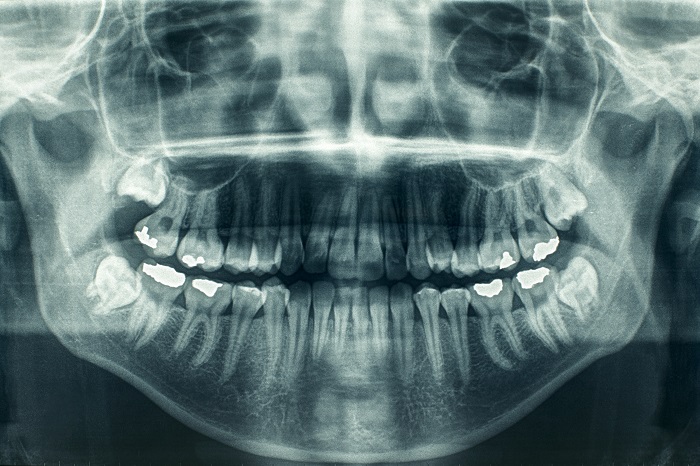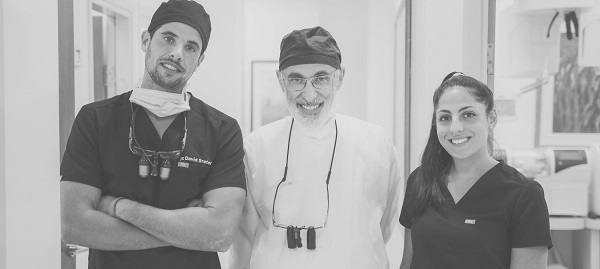
Dental Procedures
- Dental Radiographs - A Diagnostic Tool
- Getting to the root of endodontic (root canal) treatments
- Missing a tooth?
- Root Canal Therapy
- Digital Photography
Share This Page
1472 JADA, Vol. 137 http://jada.ada.org October 2006
FOR THE DENTAL PAT I E N T . . .
Dental radiographs (X-rays) can provide important information about a patient’s oral health. They help dentists examine the underlying bone, the roots of the teeth, unerupted teeth and the contact areas where teeth touch one another.
In some cases, dental radiographs can uncover a condition at an early stage before a patient experiences any signs or symptoms that something is wrong. Dental radiographs may reveal, among other things:
Dentists prescribe dental radiographs for a patient after evaluating the patient’s needs, including a review of the patient’s health history, assessment of the patient’s clinical dental history, completion of a clinical examination, evaluation of the patient’s susceptibility to dental diseases and examination of previous radiographs when available.
Based on this information, the dentist can determine if new radiographs are needed. If you are a new patient, your dentist may wish to see previous radiographs. He or she may recommend a complete-mouth series of radiographs to determine the status of the hidden areas of the mouth and to help analyze changes that may occur later.
The schedule for obtaining radiographs at recall visits varies according to age, risk of developing disease, and signs and symptoms of disease. New radiographs may be needed to determine whether any caries (decay) is present, to assess the severity of periodontal (gum) disease or to evaluate the status of growth and development.
Children may need radiographic examinations more often than adults, because their oral structures are growing and changing and because of their risk of developing caries. Radiographs can help dentists chart the progress of this growth and development and see if permanent teeth will erupt normally.
RADIOGRAPHS AND PREGNANCY
Patients should tell their dentist if they think they might be pregnant. Some dental procedures, including the radiography needed for diagnosis and treatment, may be postponed until the infant is born. However, dental disease left untreated during pregnancy can lead to problems for the mother and fetus. Dental radiographs may be required for diagnosis and treatment. A leaded apron and thyroid collar are used when pregnant dental patients undergo radiography. They help protect the patient’s abdomen and thyroid.
If a patient is concerned about the effect that any drug, dental treatment or radiograph might have on her pregnancy, she should discuss these concerns with her dentist and physician. Both are concerned about the health of the patient and infant. Also, pregnant patients should inform their dentist or physician about any radiographs that were obtained recently and discuss the availability of previous radiographs should they be needed in planning or following up on treatment.
Prepared by the American Dental Association (ADA) Division of Communications, in cooperation with The Journal of the American Dental Association and the ADA Council on Scientific Affairs. Unlike other portions of JADA, this page may be clipped and copied as a handout for patients, without first obtaining reprint permission from the ADA Publishing Division. Any other use, copying or distribution, whether in printed or electronic form, is strictly prohibited without prior written consent of the ADA Publishing Division.
“For the Dental Patient” provides general information on dental treatments to dental patients. It is designed to prompt discussion between dentist and patient about treatment options and does not substitute for the dentist’s professional assessment based on the individual patient’s needs and desires.
Copyright ©2006 American Dental Association. All rights reserved.
FOR THE DENTAL PAT I E N T . . .
Dental radiographs (X-rays) can provide important information about a patient’s oral health. They help dentists examine the underlying bone, the roots of the teeth, unerupted teeth and the contact areas where teeth touch one another.
In some cases, dental radiographs can uncover a condition at an early stage before a patient experiences any signs or symptoms that something is wrong. Dental radiographs may reveal, among other things:
- small areas of decay in the teeth and below existing restorations;
- diseases of the bone;
- abscesses or cysts;
- signs of periodontal (gum) disease;
- developmental and other abnormalities;
- some types of tumors;
- evidence of trauma;
- evidence of systemic illnesses.
Dentists prescribe dental radiographs for a patient after evaluating the patient’s needs, including a review of the patient’s health history, assessment of the patient’s clinical dental history, completion of a clinical examination, evaluation of the patient’s susceptibility to dental diseases and examination of previous radiographs when available.
Based on this information, the dentist can determine if new radiographs are needed. If you are a new patient, your dentist may wish to see previous radiographs. He or she may recommend a complete-mouth series of radiographs to determine the status of the hidden areas of the mouth and to help analyze changes that may occur later.
The schedule for obtaining radiographs at recall visits varies according to age, risk of developing disease, and signs and symptoms of disease. New radiographs may be needed to determine whether any caries (decay) is present, to assess the severity of periodontal (gum) disease or to evaluate the status of growth and development.
Children may need radiographic examinations more often than adults, because their oral structures are growing and changing and because of their risk of developing caries. Radiographs can help dentists chart the progress of this growth and development and see if permanent teeth will erupt normally.
RADIOGRAPHS AND PREGNANCY
Patients should tell their dentist if they think they might be pregnant. Some dental procedures, including the radiography needed for diagnosis and treatment, may be postponed until the infant is born. However, dental disease left untreated during pregnancy can lead to problems for the mother and fetus. Dental radiographs may be required for diagnosis and treatment. A leaded apron and thyroid collar are used when pregnant dental patients undergo radiography. They help protect the patient’s abdomen and thyroid.
If a patient is concerned about the effect that any drug, dental treatment or radiograph might have on her pregnancy, she should discuss these concerns with her dentist and physician. Both are concerned about the health of the patient and infant. Also, pregnant patients should inform their dentist or physician about any radiographs that were obtained recently and discuss the availability of previous radiographs should they be needed in planning or following up on treatment.
Prepared by the American Dental Association (ADA) Division of Communications, in cooperation with The Journal of the American Dental Association and the ADA Council on Scientific Affairs. Unlike other portions of JADA, this page may be clipped and copied as a handout for patients, without first obtaining reprint permission from the ADA Publishing Division. Any other use, copying or distribution, whether in printed or electronic form, is strictly prohibited without prior written consent of the ADA Publishing Division.
“For the Dental Patient” provides general information on dental treatments to dental patients. It is designed to prompt discussion between dentist and patient about treatment options and does not substitute for the dentist’s professional assessment based on the individual patient’s needs and desires.
Copyright ©2006 American Dental Association. All rights reserved.


